- Article
- Maritime Resources
Fisheries Management and Restoration Strategies in Chesapeake Bay
June 22, 2017
As the largest estuary in the United States with many productive fisheries , Chesapeake Bay offers a model for understanding the challenges of fishery management and restoration. Marine ecologist Anson Hines notes that s trategic, scientific, innovative , and fair management of fisheries will be essential for a planet with a growing human population and rapid global change. The following is a paper delivered during the 107th Tokyo Foundation Forum on “Sustainable Fisheries Management” on June 21, 2017.
* * *
This paper summarizes strategies of fishery management and restoration in Chesapeake Bay as a model for understanding the history, challenges and opportunities for sustainable production of fish and shellfish. As the largest estuary in the United States, Chesapeake Bay historically has supported fisheries for more than 200 species, including some of the most productive fisheries in the US with total catches from 1950 to 2015 ranging from 56,000 to 478,000 metric tons (mt) with highest production levels in 1950-1965, lowest and most variable levels from 1966-1990, and a period of recovering but moderate production from 1991-2015. Total catch value ranged from US$25million to US$289million, with highest values occurring since 2000.
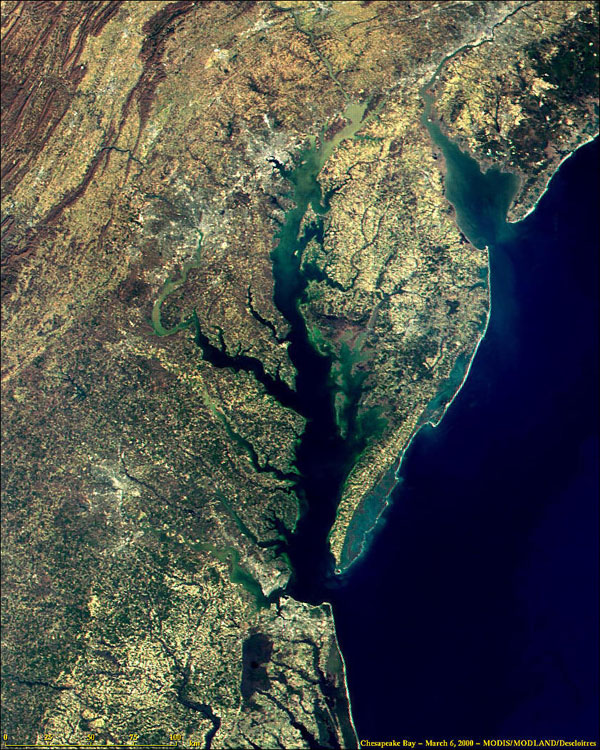
US fisheries from 3 to 200 miles offshore are governed federally by the Magnuson-Stevens Fishery Conservation and Management Act. It mandates the use of annual catch limits based on scientific fishery stock assessment to prevent overfishing, and provides for widespread market-based fishery management of catch shares. However, nearshore fisheries are managed by the states (similar to prefectures), often with disparate and poorly coordinated regulatory strategies. Regional, interstate fishery commissions were established to improve coordination among states, especially for species that have life cycles with migrations outside of individual states. Because of the size and geography of Chesapeake Bay, there are 4 fishery management jurisdictions making for complex regulations: Maryland Department of Natural Resources for the upper Bay; Virginia Marine Resources Commission the lower Bay; Potomac River Fisheries Commission for the river between the two states; and Atlantic States Marine Fisheries Commission for species that migrate out of the Bay along the eastern US coast.
Although the total value of the Chesapeake Bay fisheries has increased since 2000, catches of major species have declined drastically from the mid-1900s, including oysters, blue crabs, menhaden, river herring, and striped bass. Management and restoration efforts have focused on these high-value species as fishing intensity, pollution and habitat loss increased markedly. A brief review of these 2 shellfish and 3 finfish species illustrates the diversity of fishing and management strategies. Comparisons of these strategies provides lessons learned for managing fisheries sustainably, so that the important resources can be transferred to future generations.

Oysters ( Crassostrea virginica ) represent a failed fishery that is in a difficult management struggle to find a successful recovery strategy. In the late 1800s oysters were extremely abundant and the most valuable fishery that was mainly operated by dredging from sailing vessels in shallow water. Catch declined to 10,000 mt by the 1960s and by 2010 catch was less than 1,000 mt (1-2 percent of historical levels), as a result both of overfishing that destroyed the oyster reef structure and of introduced diseases that kill oysters at the age they reach harvest size. Restoration is promoted through state-owned hatcheries producing spat on shell that is planted onto state bottom that is subsidized by shell. The goal is to increase oyster reefs in regulated sanctuaries for increased water filtration and habitat, as well as to allow watermen to plant spat on leased bottom for commercial harvest. Growth of oysters in floating cages is increasing and production has increase to 2,000 mt with a value of US$50 million. Despite localized successes, oyster production remains at very low levels.
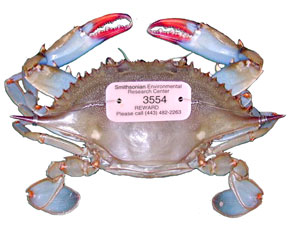
The blue crab ( Callinectes sapidus ) represents partially successful fishery management with strategies that differ markedly spatially among states. The fishery increased markedly with the advent of the crab pot (trap) in the 1940s and became the most valuable Chesapeake fishery worth US$ 80-100 million in some years. Annual catch increased to nearly 45,000 mt from 1981to 1991; however, catch declined by 50 percent by 2000. Since 1989 the abundance of the stock has been tracked with a fishery-independent survey. Despite the claims by fishermen that the decline was caused by other factors (pollution, habitat loss, predation), the survey indicated the reproductive stock of females was being intensively overfished and managers declared it a “disaster”. In 2008 the take of females was marked reduced by an array of regulations imposed by bay-wide coordination of management, including expansion of a large no-take zone of the spawning area in summer, prohibition of winter dredging for females, limited entry for commercial licenses, and other factors. Since 2010 the stock has begun to recover.
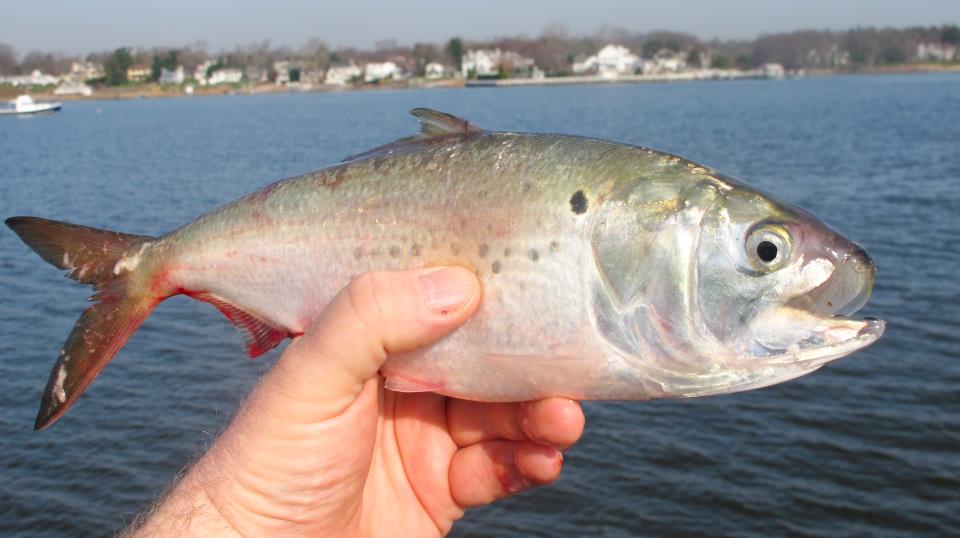
Menhaden ( Brevoortia tyrannus ) represents a fishery strategy that requires balancing narrow corporate interests with ecosystem functions. This is a small species primarily used for fish meal and oil; and it is taken primarily by a single private corporation using large purse seine nets and spotter airplanes. Since 1950 the catch has fluctuated between 150,000 and 300,000 mt with no long-term trends. However, this fish also serves as an important forage species for high value predatory fish, which have vocal competing recreational and commercial interests for restricting the catch of menhaden. Because this species migrates along the coastal states, it has been managed successfully by a quota imposed by the regional Atlantic States Marine Fisheries Commission.
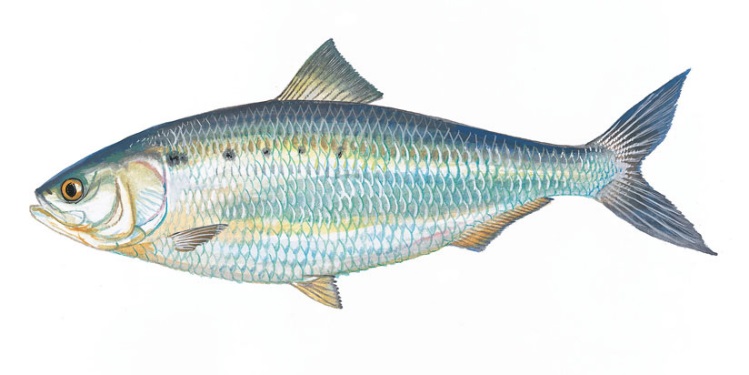
American shad and river herring ( Alosa spp.) represent a fishery management strategy that is working to recover populations from extremely low levels through a combination of habitat restoration and regulation of by-catch. These are a group of 3 small anadromous species that once supported fisheries on abundant spawning runs into Chesapeake tributaries. Now, population levels are less than 1 percent of historic levels as a result of being taken as by-catch in off-shore trawl fisheries and loss of spawning habitat due to dams and road culverts. Fishing for these species is prohibited, and recovery efforts include reducing by-catch by prohibiting trawling near off-shore schools of these species and removing river and stream obstructions. Early indications are that these efforts are allowing spawning runs to recover.
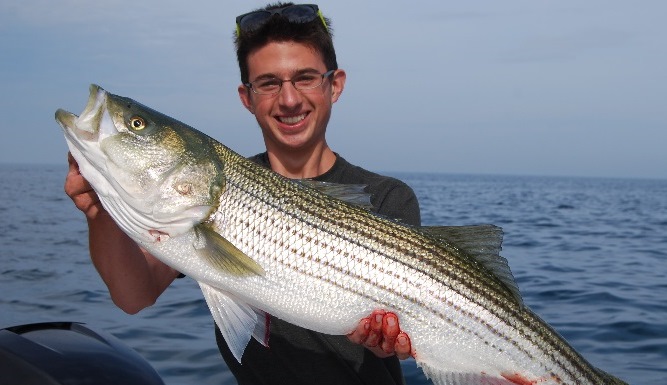
Striped bass ( Morone saxatilis ) is high quality predatory fish with a migratory life cycle and represents a notably successful management strategy to bring the fishery back from collapse. Catch from 1950 to 1975 fluctuated from 1,000 to 3,000 mt but then declined drastically to 15 mt in in 1986 as a result of intensive gill net and pen net fishing. A fishing moratorium was imposed in 1989. By 1995 the population had recovered and the moratorium was lifted, but fishing has been strictly regulated by seasonally varying size restrictions to protect the spawning stock and a quota system based on independent stock surveys to sustain the catch near 2,000 mt.
In summary, fisheries in Chesapeake Bay declined markedly over the past 100 years to very low levels that affect both the economy and ecosystem function of this great estuary. These major declines threatened the availability of these fisheries in the future. Management strategies have produced recovery of some of the most valuable fishery stocks, but not others. Although the management system for the Bay is complex, comparisons of the 5 species above demonstrates useful lessons for successful management strategies and the ability to sustain these resources for future generations:
1. Management must be based scientifically both on accurate fishery-independent stock assessment at frequent intervals and on accurate measures of catch and fishing effort. These allow objective measure of fishing and management success; and they provide the ability to distinguish short-term fluctuations from long-term trends.
2. While it is important to prevent pollution and habitat degradation, overfishing and destructive fishing methods have been the major cause of fishery declines. Recovery requires management to set and effectively regulate fishing pressure and catch levels at long-term sustainable levels, despite objections from fishermen with short-term objectives. Giving in to fishermen demands for less restriction and increased access consistently results in devastating overfishing that deprives these resources from future generations.
3. Transparency and open communication of information and management rationale is important. This holds managers accountable for their decisions, but also provides the opportunity for adaptive management and adjusting regulations with new information and varying conditions. This allows the competing interests to debate and participate in decisions for effective strategies to control fishing effort and catch levels.
4. Fairness of fishing regulations is essential. Enforcement is easier and less expensive when regulations are fair. In addition, all regulations have economic and social trade-offs and consequences. For example, Chesapeake strategies for restricting fishing effort differ greatly between the states of Maryland and Virginia. Fishing commercial blue crab licenses are unlimited in Maryland, which makes fishing effort difficult to control and measure; but this also allows for more open and fair competition in the fishery. By contrast, Virginia licenses are strictly limited, which keeps the size and entry into the fishing effort tightly controlled and easily tracked. However, this restriction is often criticized as unfairly preventing open competition for natural resources that are shared by all citizens.
Commitment to the future of fisheries is critical for a planet with a growing human population concentrated in the coastal zone and rapid global change. With limited freshwater resources restricting food production from agriculture, the demand for protein from our coastal waters will continue to increase. Strategic, scientific, innovative and fair management of fisheries is essential for future generations.
